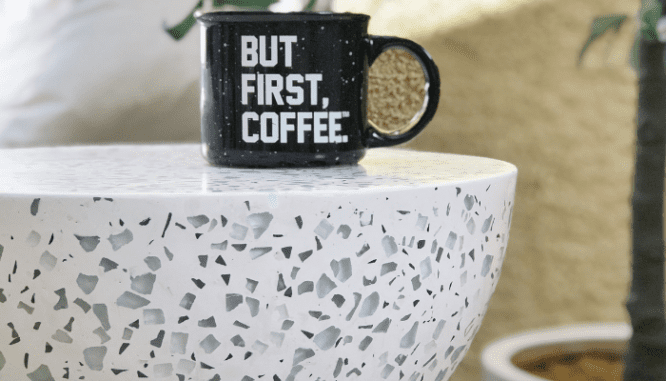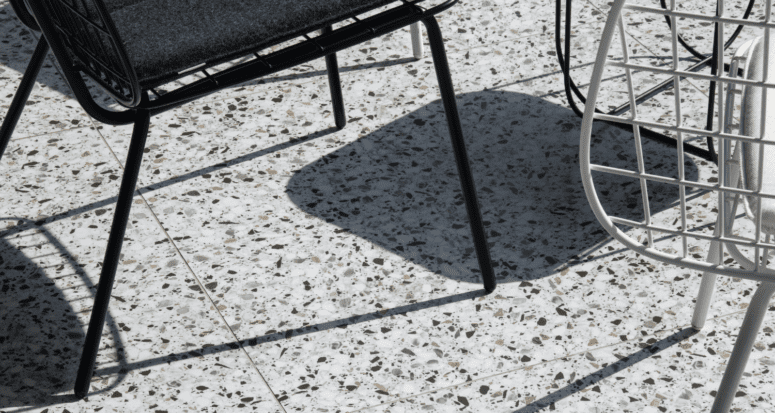Terrazzo’s Modern Renaissance: 3 Ways to Bring The Classic Venetian Material Home
- Published on
- 5 min read
-
 Allaire Conte Contributing AuthorClose
Allaire Conte Contributing AuthorClose Allaire Conte Contributing Author
Allaire Conte Contributing AuthorAllaire Conte is a writer with a passion for real estate, technology, and nature. She holds her MFA in Nonfiction Writing from Columbia University and is based in Brooklyn.
After years of being relegated to garage floors, terrazzo is finally getting the spotlight it deserves. This material has been on a steady upward trend since 2014, riding on the coattails of other design trends like mid-century modern, art deco, and sustainable building. And now, the buzz about terrazzo has reached a fever pitch.
But what is this confetti-like material, and where does it belong in your home? We’ll break down everything you need to know about terrazzo and home design.

What is terrazzo?
Terrazzo is a composite material of aggregate (most often bits of natural stone or glass) and a binder (most often epoxy or cement) known for its confetti-like appearance. Because of the engineered nature of this material, just about any color combination is possible.
Ralph Severson, the founder and CEO of Indiana’s top-rated Flooring Masters, says he’s used terrazzo for just about everything – countertops, floors, built-in furniture, and more. He says, “We’ve created everything from a terrazzo topped picnic table to a terrazzo patio and matching furniture.”
Not only is this material versatile, but it’s also sustainable. You can opt for VOC-free binders and recycled aggregates and lower the environmental impact of your remodel.
Origins of the trend: Terrazzo hails from 16th century Venice
You read that right: while many might associate terrazzo with art deco design in the time of the Rockefellers, this material can be traced back to the age of Michaelangelo.
Terrazzo was invented by Venetian mosaic workers, who discovered that they could reuse their marble scraps by laying them in plaster and grinding down the composite material to a level surface with a grinding stone, called a galero. These early artisans sealed terrazzo floors with a coating of goat’s milk, which imbued a sheen to the pieces of marble.
Terrazzo remained a trade secret in Italy for centuries before the mass Italian migration spanning from the 1880s through the 1920s. During this time, more than four million Italians immigrated to America, including craftsmen who carried the technical knowledge and skill to bring terrazzo with them.
Terrazzo comes to America
One of the first installations of true Venetian terrazzo in the United States was in 1890 when Italian craftsmen were recruited to lay terrazzo floors in the Vanderbilt Mansion on Fifth Avenue in New York. The craftsmen were known as the “terrazeri” and were highly regarded for their skills.
Soon after terrazzo’s American debut in the Vanderbilt mansion, the material became a favorite of Jazz Age art deco designers who regarded it for its versatility and myriad of patterns.
Terrazzo today
Today, designers use terrazzo for countertops, floors, even furniture. While the charismatic material never disappeared entirely, its most recent resurgence in popularity went hand and hand with a rise in mid century modern style (as seen in Mandy Moore’s Pasadena home featured in Architectural Digest).
All signs indicate that terrazzo is here to stay. For one, terrazzo is a popular choice for green homes and LEED-certified buildings. As more homeowners opt for green building materials (a Nielsen study found that 66% of millennials are willing to pay more for green products), you can expect builders to continue incorporating this material into their home designs.

Bringing terrazzo home: 3 Places to feature this colorful material
Don’t put terrazzo in a box. You can incorporate this versatile material to bring a pop of color and personality to any room.
Terrazzo flooring
As flooring, terrazzo’s durability shines. When asked about the longevity of terrazzo, Ralph Iorio, an expert agent who outsells the average Margo Island agent by 35% says laughing, “Terrazzo flooring, in particular, lasts forever. They can be restored very nicely as well.”
From a style perspective, terrazzo flooring is highly customizable and can be used to make intricate patterns, designs, and even logos for your floors.
The installation process is complex, though, and is best left to professionals. Severson describes it:
“A base layer of concrete is poured and set. Then forms are removed and replaced by metal dividers. A layer of sand is laid to prevent cracking. Then a thin layer of concrete for outdoor — [or] epoxy for indoor — is mixed with the chips and poured. Additional chips are placed on the surface then rolled into the mix so that they will remain prominent at the surface.”
To finish the job, the material is ground down and polished just like the first terrazzo floors in Venice were — but don’t expect a goat’s milk finish. Instead, a commercial sealer is applied to protect your floor from wear and tear. To keep your floors immaculate, reapply this sealant only every few years.
If you’re feeling overwhelmed by options, Iorio offers some advice. He says he’s noticing a shift away from coastal patterns. “Seems to me that there’s a lean towards a more industrial look today … at least in single-family homes right now and in industrial-looking buildings.”
Average cost: $25-$90 per square foot, although the flooring can be more expensive depending on the intricacy of the chosen design.
Terrazzo countertops
Terrazzo is also used for countertops thanks to its durability, low-maintenance care, and cost-effectiveness. As a countertop, terrazzo outperforms many natural stones because of its resistance to scratches, chips, and stains. However, it can sometimes be sensitive to heat, depending on the binding and sealing agents, so be sure to use trivets for hot pans. Maintenance-wise, you only need to reseal terrazzo every few years.
As if that weren’t enough to sell you, terrazzo countertops are customizable – you can choose the size of the aggregate, the color of the aggregate, the type of binder, and the color of the binder. While there are only two options for binder material – epoxy resin or cement – there are infinite combinations of aggregate and binder colors.
Today, most homeowners prefer larger Venetian aggregates and neutral colors, as well as styles that mimic natural stone patterns like granite.
Average cost: $50-$100 per square foot
Terrazzo furniture
Despite this material’s economical nature, terrazzo furniture can be on the pricier side. These pieces are often heavy and cumbersome to ship, which is why you’re unlikely to see terrazzo furniture at fast furniture retailers like Wayfair and IKEA. This means you’ll likely need to buy from luxury and higher-end furniture designers, which can put a dent in your wallet – like this $5,300 terrazzo bench from 1stDibs or this terrazzo coffee table from CB2 for $299.
But don’t let sticker shock scare you away: this durable, sustainable, and on-trend material is a solid alternative to flat-pack furniture that you’ll likely replace every two years. If you invest more upfront, you can avoid falling prey to the buy cheap, buy twice cycle.
Want to play terrazzo yourself? Try your hand at DIY furniture making with a terrazzo casting kit. Not only will you create a piece of furniture to last generations, but you’ll also take pride in knowing you’ve participated in an artform dating back to the Renaissance.
Lasting trend or passing fad?
Whenever there is a new craze in design, this question deserves to be asked and answered. In the case of terrazzo, though, the material has already proven to withstand the test of time. That’s because terrazzo isn’t just a trend; it’s an art form. And if you’re still not convinced, consider this: the enduring beauty of St. Peter’s Basilica – which features terrazzo floors installed in 1546 by Michaelangelo himself – isn’t going out of style any time soon.
To ensure that your terrazzo features are as timeless as a work of Renaissance art, opt for a neutral style in a shade like gray, beige, or the goldilocks “greige.” These neutral tones paired with terrazzo’s durability will make your terrazzo’s luster and appeal last through the decades.
Whatever the option you choose for your terrazzo features, this is a love to last a lifetime. From St. Peter’s Basilica to the Vanderbilt mansion, and now your home: This material’s illustrious history has never been more accessible.
Header Image Source: (Jean-Philippe Delberghe / Unsplash)
